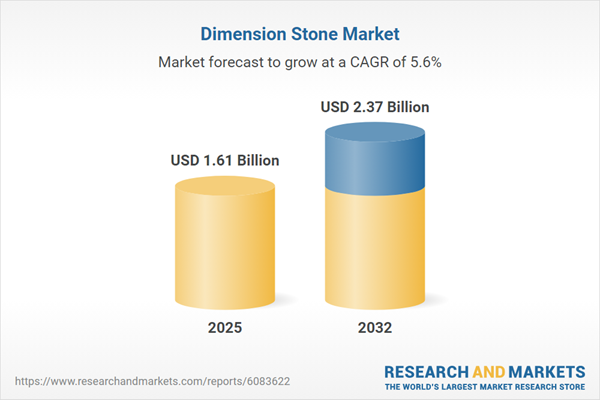Speak directly to the analyst to clarify any post sales queries you may have.
Dimension stone continues to gain traction as an essential material for modern built environments, valued by senior executives for its enduring appeal, broad applicability, and alignment with shifting industry demands. Companies adopting dimension stone can address evolving client requirements while ensuring project resilience and design differentiation.
Market Snapshot: Dimension Stone Market
The Dimension Stone Market expanded from USD 1.53 billion in 2024 to USD 1.61 billion in 2025 and is projected to reach USD 2.37 billion by 2032, reflecting a strong compound annual growth rate of 5.60%.
Market momentum is driven by a diverse array of applications in construction, infrastructure, landscaping, and interior design. Both established and emerging markets are actively investing in urban expansion, integrating dimension stone into a wide spectrum of projects. Sectoral strength is further supported by technological advancements and a mounting focus on sustainable sourcing practices, underscoring ongoing opportunity and resilience amid global change.
Scope & Segmentation
This report delivers a thorough analysis of the dimension stone market landscape, ensuring decision-makers have the data required to optimize strategy in a competitive environment. Coverage includes:
- Product Types: Granite, Limestone, Marble, Quartzite, Sandstone, Slate, Travertine ensure material flexibility for diverse project specifications, with each stone type offering unique functional and aesthetic characteristics.
- Applications: Countertops across residential and commercial settings; facades for both composite and solid stone installations; versatile flooring solutions for indoor and outdoor spaces; landscaping components spanning hardscaping and decorative uses; memorials and monuments for institutional or specialty projects; wall cladding suited to interior and exterior environments.
- End Users: Commercial projects (including hospitality, office, retail); industrial environments (manufacturing, warehousing); infrastructure (covering energy, transport, water sectors); institutional structures (education, government, healthcare); residential developments for new construction and renovations.
- Distribution Channels: Direct sales, distribution via retailers and wholesalers, and expansion into online platforms both company-operated and through third parties to increase reach and accessibility.
- Regions: Detailed insights for the Americas, Europe, Middle East & Africa, and Asia-Pacific with in-depth evaluation of key countries and subregions shaping regional demand and supply trends.
- Leading Companies: Profiles featuring Polycor Inc., Levantina Group S.L.U., R.E.D. Graniti S.r.l., Antolini Luigi & C. S.p.A., MIA Stone Group LLC, Cosentino S.A., MSI Surfaces, Inc., Fujian Yuanlong Stone Group Co., Ltd., Xiamen Mainstone Co., Ltd., and Greco Marble S.A. highlight best practices in production, supply chain management, and international expansion.
This comprehensive segmentation clarifies competitive positions, illuminates technological adoption, and outlines regional dynamics vital for senior leadership decision-making.
Key Takeaways
- Sustainability in quarrying and manufacturing is increasingly central, driving companies to adopt closed-loop processes and to realign supply chains to meet regulatory and stakeholder priorities.
- Modern fabrication solutions, such as waterjet and wire saw technology, are improving design possibilities and operational efficiency, particularly in specialized and complex installations.
- Uptake of automation and digital design tools within key regions, especially the Americas and Asia-Pacific, is contributing to greater process efficiency and enabling firms to support large-scale infrastructure ambitions.
- The circular economy approach is accelerating, with rising utilization of stone waste and offcuts in landscaping and decorative contexts meeting evolving sustainability benchmarks.
- Enterprises are forming regional alliances and developing adaptable distribution networks to counteract market volatility, ensuring sourcing flexibility and continuity against trade barriers.
- Businesses aligning with these trends are positioned to strengthen project resilience, exceed client expectations, and maintain responsible industry reputations.
Tariff Impact
Recent tariff developments in the United States are prompting companies to reassess their procurement and sourcing strategies within the dimension stone supply chain. Importers are diversifying supplier bases and establishing robust relationships with local and regional firms. There is a marked trend toward increased domestic extraction and processing, supported by logistics providers offering tailored warehousing and transportation options. These actions collectively enhance supply chain resilience and minimize exposure to regulatory changes impacting global trade.
Methodology & Data Sources
This report’s findings are built upon a multi-layered research methodology, combining a detailed literature review, direct interviews with industry stakeholders, and on-site analysis at quarrying and processing locations. Quantitative data—including yield and equipment performance metrics—have been rigorously validated using proprietary datasets and published studies to ensure actionable and reliable insights.
Why This Report Matters
- Access focused analysis of current trends, operational innovation, and emerging trade challenges impacting the dimension stone market.
- Leverage clear segmentation and data-driven guidance for investment prioritization, supply chain optimization, and regional opportunity targeting.
- Benchmark your organization against major competitors and adaptable supply models to prepare for long-term market shifts and evolving sustainability expectations.
Conclusion
The dimension stone sector is distinguished by the convergence of sustainable sourcing, advanced design, and dynamic demand. Organizations that integrate these capabilities will be equipped to advance market leadership and deliver value in continuously evolving environments.
Table of Contents
3. Executive Summary
4. Market Overview
7. Cumulative Impact of Artificial Intelligence 2025
Companies Mentioned
The companies profiled in this Dimension Stone market report include:- Polycor Inc.
- Levantina Group S.L.U.
- R.E.D. Graniti S.r.l.
- Antolini Luigi & C. S.p.A.
- MIA Stone Group LLC
- Cosentino S.A.
- MSI Surfaces, Inc.
- Fujian Yuanlong Stone Group Co., Ltd.
- Xiamen Mainstone Co., Ltd.
- Greco Marble S.A.
Table Information
| Report Attribute | Details |
|---|---|
| No. of Pages | 194 |
| Published | October 2025 |
| Forecast Period | 2025 - 2032 |
| Estimated Market Value ( USD | $ 1.61 Billion |
| Forecasted Market Value ( USD | $ 2.37 Billion |
| Compound Annual Growth Rate | 5.6% |
| Regions Covered | Global |
| No. of Companies Mentioned | 11 |









